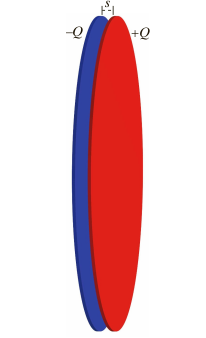Capacitor: Difference between revisions
No edit summary |
|||
| Line 6: | Line 6: | ||
== Electric Field== | == Electric Field== | ||
[[File:capacitor3.png|thumb|alt=A cartoon centipede reads books and types on a laptop.|The Wikipede edits ''[[Myriapoda]]''.]] | |||
===Electric Field of two uniformly charged disks: A Capacitor=== | ===Electric Field of two uniformly charged disks: A Capacitor=== | ||
The Electric Field of a Capacitor can be found by the formula: | The Electric Field of a Capacitor can be found by the formula: | ||
Revision as of 14:50, 19 November 2015
Short Description of Topic
This page is all about the Electric Field due to a Point Charge.
Electric Field

Electric Field of two uniformly charged disks: A Capacitor
The Electric Field of a Capacitor can be found by the formula:
Electric field near the center of a two-plate capacitor
[math]\displaystyle{ \ E=\frac{Q/A}{\epsilon_0 } }[/math] One plate has charge [math]\displaystyle{ \ +Q }[/math] and other plate has charge [math]\displaystyle{ \ -Q }[/math]; each plate has area A; Direction is perpendicular to the plates. Assumption: separation between capacitor is very small compared to the area of a plate.
Fringe Field (just outside the plates near center of disk)
[math]\displaystyle{ \ E_{fringe}=\frac{Q/A}{2\epsilon_0 }(\frac{s}{R}) }[/math] [math]\displaystyle{ \ s }[/math] is the separation between plates; [math]\displaystyle{ \ R }[/math] is the radius of plate